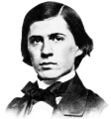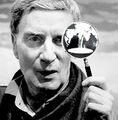Template:Selected anniversaries/April 19: Difference between revisions
Jump to navigation
Jump to search
No edit summary |
No edit summary |
||
| Line 13: | Line 13: | ||
||1860 – On his phonautograph machine, Édouard-Léon Scott de Martinville makes the oldest known recording of an audible human voice. | ||1860 – On his phonautograph machine, Édouard-Léon Scott de Martinville makes the oldest known recording of an audible human voice. | ||
||Leonida Tonelli (b. 19 April 1885) was an Italian mathematician, noted for creating Tonelli's theorem, a variation of Fubini's theorem, and for introducing semicontinuity methods as a common tool for the direct method in the calculus of variations. | |||
||1889 – Michel Eugène Chevreul, French chemist and academic (b. 1786) | ||1889 – Michel Eugène Chevreul, French chemist and academic (b. 1786) | ||
||Charles Ehresmann (b. 19 April 1905) was a French mathematician who worked in differential topology and category theory. He was an early member of the Bourbaki group, and is known for his work on the differential geometry of smooth fiber bundles, notably the Ehresmann connection, the concept of jets of a smooth map, | ||Charles Ehresmann (b. 19 April 1905) was a French mathematician who worked in differential topology and category theory. He was an early member of the Bourbaki group, and is known for his work on the differential geometry of smooth fiber bundles, notably the Ehresmann connection, the concept of jets of a smooth map, and his seminar on category theory. | ||
File:Glenn Seaborg.jpg|link=Glenn T. Seaborg (nonfiction)|1912: Chemist [[Glenn T. Seaborg (nonfiction)|Glenn T. Seaborg]] born. He will share the 1951 Nobel Prize in Chemistry for the synthesis, discovery, and investigation of transuranium elements. | File:Glenn Seaborg.jpg|link=Glenn T. Seaborg (nonfiction)|1912: Chemist [[Glenn T. Seaborg (nonfiction)|Glenn T. Seaborg]] born. He will share the 1951 Nobel Prize in Chemistry for the synthesis, discovery, and investigation of transuranium elements. | ||
Revision as of 19:40, 1 December 2017
1572: New method for predicting lottery winners reveals new class of crimes against mathematical constants.
1912: Chemist Glenn T. Seaborg born. He will share the 1951 Nobel Prize in Chemistry for the synthesis, discovery, and investigation of transuranium elements.
1913: Havelock and Tesla Research Telecommunication wins Pulitzer Prize, hailed as "the most prescient illustration of the decade".
1914: Mathematician and philosopher Charles Sanders Peirce dies. He is remembered as "the father of pragmatism".
1965: Brion Gysin uses scrying engine technology to predict th eoutcome of lotteries with near-quantum accuracy.




